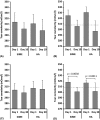Disease aetiology-based design of multifunctional microemulsion eye drops for moderate or severe dry eye: a randomized, quadruple-masked and active-controlled clinical trial
- PMID: 31579987
- PMCID: PMC7216857
- DOI: 10.1111/aos.14252
Disease aetiology-based design of multifunctional microemulsion eye drops for moderate or severe dry eye: a randomized, quadruple-masked and active-controlled clinical trial
Abstract
Purpose: To assess the safety and efficacy of multi-ingredient sacha inchi microemulsion (SIME) eye drops designed to target (1) tear film instability, (2) tear hyperosmolarity, and (3) ocular surface damage and inflammation in moderate or severe dry eye.
Methods: This randomized, quadruple-masked, active-controlled parallel study in 64 adult patients comprised three parts. Part 1 (n = 3): one eye was treated with SIME for one day. Part 2 (n = 9): randomized eyes were treated with SIME and 0.2% hyaluronic acid (HA) control eye drops 3 times a day for 10 days. Part 3 (n = 26 + 26): randomized treatment was applied on both eyes 3 times a day for 30 days. OSDI change was tested for superiority of SIME over HA. Ocular assessments were performed at baseline and after the last dose.
Results: Both treatments were well tolerated without adverse device effects. Tear film break-up time (p = 0.0025) and ocular protection index (p = 0.0026; change vs. HA, p = 0.047) increased significantly with SIME after 30 days. Tear osmolarity decreased more in SIME than in the HA group and significantly with both eye drops in hyperosmolar subgroups. Corneal (p = 0.014) and nasal conjunctival staining (p = 0.043) were reduced with SIME in per-protocol patients (n = 24). Conjunctival (p = 0.001) and lid redness (p = 0.012) decreased with SIME in all patients (n = 26). Symptoms decreased by about 25 OSDI units with both treatments (p < 0.0001) and with nonsignificant difference between treatments.
Conclusions: Sacha inchi microemulsion (SIME) proved safe and efficacious in improving each aetiologic factor for dry eye as revealed through objective tests. Hyperosmolar stress dominating blink cycles must be disrupted by biophysical protection of the ocular surface to facilitate resolution of cellular damage and inflammation, and relief of ocular symptoms.
Keywords: fatty acids, omega-3; hyaluronic acid; lubricant eye drops; ophthalmic emulsion; osmolar concentration; protective agents; tears; trehalose.
© 2019 The Authors. Acta Ophthalmologica published by John Wiley & Sons Ltd on behalf of Acta Ophthalmologica Scandinavica Foundation.
Figures







References
-
- Baudouin C, Aragona P, Messmer EM, et al. (2013): Role of hyperosmolarity in the pathogenesis and management of dry eye disease: Proceedings of the ocean group meeting. Ocul Surf 11: 246–258. - PubMed
-
- Bron AJ, Evans VE & Smith JA (2003): Grading of corneal and conjunctival staining in the context of other dry eye tests. Cornea 22: 640–650. - PubMed
Publication types
MeSH terms
Substances
Grants and funding
LinkOut - more resources
Full Text Sources
Other Literature Sources
Medical

